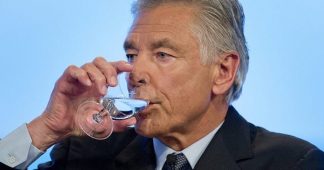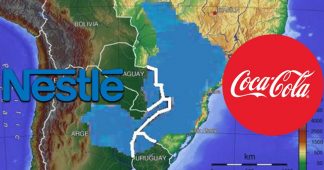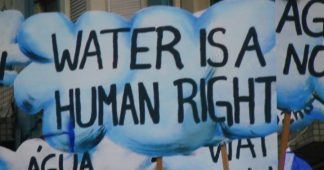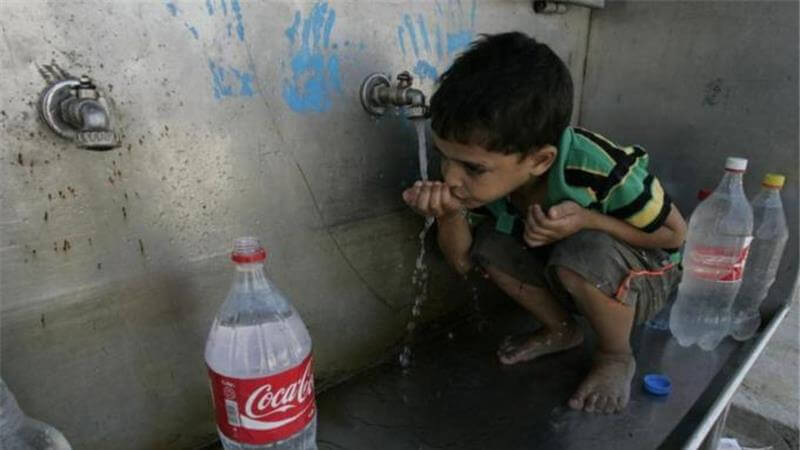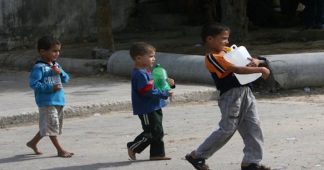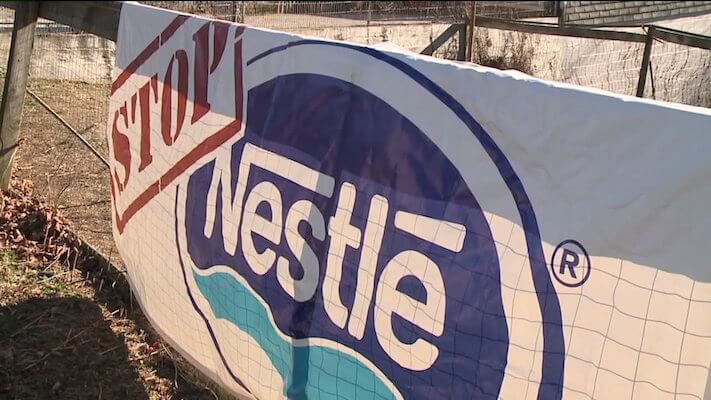By Peter Koenig
22 March 2018
Today, 22 March 2018, marks World Water Day. It is also the week, when the 8th World Water Forum (WWF-8) convenes, 18 to 23 March 2018, in Brasilia. It is no coincidence, for sure, that Brazil was chosen for this noble WWF – about the water equivalent to the political and corporate elites, represented at the WEF – World Economic Forum, in Davos. The two are intimately related, and interlinked, as we will see.
The WWF is organized by the World Water Council, just another layer to confuse who is who in the circus of water elitists attempting to control a vital source of life – freshwater. The WWF prides itself with an honorable mission statement: “To promote awareness, build political commitment and trigger action on critical water issues at all levels, to facilitate the efficient conservation, protection, development, planning, management and use of water in all its dimensions on an environmentally sustainable basis for the benefit of all life”.
There you have it. Nestlé, Coca Cola, PepsiCo, Dow Chemicals and other transnationals with strong water interests, Veolia, Suez (French), Thames (UK), Bechtel (US), Petrobras and a myriad of others, join together with the World Bank, Inter-American Development Bank (IDB), different UN bodies, and many multi- and bilateral donors, so-called development institutions – as well as dozens more ultra-liberal organizations, NGOs and corporations, pretending to work for the good of humanity; for the good of hundreds of millions of people who persistently are deprived of affordable potable water by an onslaught of water privatization (Organizers and supporters of the WWF: http://www.worldwaterforum8.org/en/organizers-and-supporters).
Another layer of this prominent international water forum is the World Bank-created Water Resources Group (WRG). Its chief purpose is to pursue the Sustainable Development Goal 6 (SDG-6), “Clean Water and Sanitation”. The WRG’s leadership is composed of an interwoven group of individuals and institutions, such as the head of the WEF, leadership of Nestlé, Coca Cola, PepsiCo, Dow Chemicals, the UN (UNDP) … and the Global Water Partnership (GWP), yet another layer within the maze of the global water mafia, created by the usual ‘suspects’, World Bank, UN (UNDP), and a number of multi- and bilateral development agencies, whose priority focus is on water, i.e. the Swiss, the Swedes, the Dutch…
And not to forget – also present at the WWF is the International Groundwater Resources Assessment Centre (IGRAC), part of UNESCO, based at the IHE Delft Institute for Water Education, whose mission is sharing information on worldwide groundwater resources, in view of protecting them, and focusing mainly on transboundary aquifer assessment and groundwater monitoring.
By and large, the WWF is the sum of this tremendous non-transparent, complex colossus of institutions and technocrats that is gradually taking over control of the global freshwater resources. This is happening under our eyes and under a seemingly anodyne promotion logo – PPP = Public Private Partnership which means in reality, the Public puts at disposal of the Private sector its publicly funded and publicly-owned infrastructure and water resources, to be exploited for profit at the detriment of the very public, who paid for the infrastructure and whose life depends on this vital resource, water.
Privatization of freshwater resources is a crime, but it’s the name of the game. Just look who is prominently represented in the World Bank-created Water Resources Group – it’s IFC, the International Finance Corporation, the private sector development branch of the World Bank Group.
The result of these multiple and often repetitive meetings and gathering is largely zero – safe for a litany of recommendations and resolutions whose implementation hardly ever see the light of the day. Imagine the tremendous annual cost of running this multi-agency sham; mostly business class travel, food and lodging (five-star accommodations), of the high-level technocrats crisscrossing the globe from one conference to another! – Millions and millions of dollars per year. How many people could be served with drinking water and safe sanitation for this amount of money?
The WHO / UNICEF Joint Monitoring Program (JMP) estimates (July 2017) that “some 3 in 10 people worldwide, or 2.1 billion, lack access to safe, readily available water at home, and 6 in 10, or 4.5 billion, lack safely managed sanitation.” – This, out of a world population of about 7.4 billion.
Maude Barlow, chairperson of the Council of Canadians and of World Water Watch, and author of “Blue Gold” (2002), “Blue Covenant” (2007), and of “Blue Future: Protecting Water for People and the Planet Forever” (2013), refers in the latter to the WEF 2010 which under the aegis of the WRG was launching a platform of public-private partnership, to help engage mainly developing country governments in ‘reforming’ the water sector, i.e. putting it into the hands of private water corporations. Many of these countries have no choice, if they want to continue receiving “development” funds from the World Bank and Co. Barlow is also the founder of the Blue Planet Project, seeking to protect vital water resources, like the Guarani Aquifer for future generations.
—–
Flashback to the World Economic Forum in Davos (January 2018). Brazilian President Temer attended this year’s WEF. Temer, a corrupt criminal, should be in prison rather than running a most wonderful country, Brazil, into the ground. Literally. His only purpose to be in Davos was to tell this elite forum about his intention to sell out and privatize his country, foremost water resources.
How did such a dishonest person become president of Brazil? – Washington, who else, put him there. Against all odds. The dark Zion-handlers representing the US financial sector removed an honest Dilma Rousseff and replaced her with Michel Temer, at that time an indicted crook. The indictment was lifted as he was supposed to be made President. It is still beyond me how this could happen, as Dilma had the entire military on her side and could have called a state of emergency to halt the parliamentary ‘regime change’ charade, instigated by the US. She didn’t. Somebody must have threatened her.
By now we know how Washington manipulates elections and other political processes around the world – by the shady methods of Cambridge Analytica (CA) http://www.informationclearinghouse.info/49028.htm, a ‘marketing’ consultancy that steals personal data from internet, foremost from facebook, to target specific segments of a population with specific messages to influence their opinion. By their own account, CA methods have been applied in over 200 cases around the globe within the last 3 to 4 years, to influence elections and other political processes, including in Argentina, Brazil, Peru, Colombia, the UK (Brexit), Germany, France and many more. This is true meddling in other countries’ sovereign affairs, by the one and only rogue state of this globe, the United States of America. And they are talking about Russian meddling in the 2016 US Presidential Elections!
Stealing by stealth is one of the neoliberal crimes we haven’t quite understood yet, let alone mastered. Hindsight is always 20/20. This article hopes to contribute to foresight.
———-
Brazil, with about 8,200 km3 annually renewable freshwater, ranks number one with about one eighth (1/8) of the world’s total renewable freshwater resources which are estimated at 45,000 km3. The Amazon Basin holds about 73% of all of Brazil’s freshwater. Renewable freshwater is the composite of annually sustainable surface and groundwater recharge combined (recharge by precipitation and inflow from outside). The second most water-abundant country is Russia with 4,500 km3 / year, followed by Canada, Indonesia, China, Colombia, US, Peru, India – all with renewable water resources of between 2,000 and 3,000 km3 / year.
By Continent, the Americas have the largest share of the world’s total freshwater resources with 45 percent, followed by Asia with 28 percent, Europe with 15.5 percent and Africa with 9 percent. This scenario immediately points to Africa’s vulnerability. Africa is clearly the most vulnerable Continent from a water resources – survival – point of view. Africa is also home to about 60% of the world’s remaining and known available natural resources; resources the west covets and goes to war for.
Is it, therefore, a coincidence that the 8th WWF is held in Brazil? – I don’t think so. Especially not with Temer going to Davos, where the cream of the crop of the world’s corporate, finance and institutional elite meets, to offer Brazil’s water resources for privatization.
—–
We are talking about privatizing the largest single underground renewable freshwater reservoir in the Americas, arguably in the world, the Guarani Aquifer which underlays 1.2 million square kilometers – km2 (about the size of Texas and California combined), of which 71% is under Brazil, 19% under Argentina, 6% under Paraguay, and 4% under Uruguay.
The Guaraní aquifer was discovered in the 1990s. It is named after the indigenous people who have inhabited the area for centuries. The Guarani holds an estimated 46,000 km3 of freshwater (not to confound with the annual renewable freshwater, of which Brazil has about 8,300 km3 – see above). The current Guarani’s extraction rate is a little over 1 km3 per year, while the potential recharge rate is between 45 km3 and 55 km3/year, meaning that there is so far no risk of over-abstraction. This could however, change quickly. It is said that the Guaraní could supply the world population for the next 200 years with 100 liters per capita per day.
About 30 million people inhabit the Guarani region. In the Brazilian section of the Guaraní, some 500 to 600 cities are currently supplied with Guaraní water – how many of these municipal supplies are already privatized?
In late February 2018, Blue Planet founder, Maude Barlow, tweeted, “Terrifying! Coke and Nestle want to buy up the Guarani Aquifer! Must be stopped!!!”. As Mint Press reports “A concerted push is underway in South America that could see one of the world’s largest reserves of fresh water soon fall into the hands of transnational corporations such as Coca-Cola and Nestlé. According to reports, talks to privatize the Guarani Aquifer – a vast subterranean water reserve lying beneath Argentina, Brazil, Paraguay, and Uruguay – have already reached an advanced stage. The deal would grant a consortium of U.S. and Europe-based conglomerates exclusive rights to the aquifer that would last over 100 years.”
Under such concession arrangements, quantities to be abstracted are usually unlimited, which would leave the entire aquifer in the hands of those private corporations which are part and parcel of the Temer negotiated deal.
The article adds, “In Brazil, intense lobbying has been underway since at least 2016 to tap into the aquifer. These efforts fell under the spotlight late last month [in January 2018] at the World Economic Forum in Davos, Switzerland, where private talks were reported between Brazil’s President Michel Temer and a range of top executives with interests in the aquifer, including Nestle CEO Paul Bulcke, Anheuser-Busch InBev CEO Carlos Brito, Coca-Cola CEO James Quincey, and Dow Chemical CEO Andrew Liveris.”
The article further mentions, “As leading Brazilian water-rights activist Franklin Frederick noted in Brasil de Fato, these companies belong to the 2030 Water Resources Group (2030WRG), a transnational consortium that includes AB Inbev, Coca-Cola, Dow, Nestle and PepsiCo. 2030WRG bills itself as ‘a unique public-private-civil society collaboration’ and hides its intention to privatize developing nations’ water supplies by claiming to ‘facilitate open, trust-based dialogue processes to drive action on water resources reform in water-stressed countries in developing economies’ and ‘close the gap between water demand and supply by the year 2030’.”
Already in September 2016, Reuter reported that Brazil – Temer – “launched a multibillion-dollar plan to auction off oil, power rights and infrastructure concessions.” And the Correio do Brasil retorted that this “privatizing wrath” could extend to the Guarani Aquifer. A senior official at the National Water Agency (ANA) has revealed that the Guarani aquifer will appear on the list of public goods to be privatized.
Barlow, in a Conference in Florianapolis, Brazil, already in November 2011, said, the biggest concern for humanity is the potential for the Guarani to become controlled by private interests. She added, corporations have already preferential access to these waters. “You are sitting atop a vast reserve of water in a very thirsty world, a reserve that is not only vital to the health and future of this region but to all of humanity. It is a treasure that must be protected by governments on behalf of the people and the ecosystems of the region.”
Recent studies point to an even larger underground water reservoir system, the “underground ocean” of Amazonia. It is projected to hold 160 trillion m3 (160,000 km3) of freshwater, underlaying mainly Brazil, but also Venezuela, Peru, Colombia and Ecuador. Studies are still ongoing and it might be too soon to draw definite conclusions. However, these gigantic water reserves under Latin America plus the Nubian Sandstone Aquifer System (NSAS) which is the world’s largest known fossil aquifer of an estimated 150,000 km3 of non-renewable groundwater, must be protected for humanity.
The NSAS is located under the Eastern end of the Sahara Desert. It stretches over 2 million km2 and spans four countries in North and Central Africa, Libya, Sudan, Chad and Egypt.
—–
Back to the WWF in Brasilia, where the “water mafia” is convening as this article goes to print, and while in São Lourenço, Minas Gerais, 600 “Women Without Land” occupy Nestlé’s Brazil headquarters, since 6 AM Tuesday morning, 20 March. Nestlé, the Swiss food and water giant, declared water number one in its field of business expansion. Nestlé controls already more than 10% of the world market of bottled water. The “Women without Land” denounce Temer’s policy of handing out their precious water resources to international corporations. Aware of the ongoing WFF, they warn of further concession contracts being negotiated on the sidelines of this forum.
One of the leaders said, “Imagine you are obliged to buy your water in bottles to quench your thirst. This is what they want these transnational corporations, officially debating improved water management in Brasilia, when in reality they are negotiating concessions of our water at fire-sales prices.”
We, the People, the 99% of this globe, have the moral obligation to stand up against this globalized, neofascist clandestine onslaught to privatize and steal our vital water resources – humanity’s survival. Water is Life. If we don’t have the foresight to stand up now, to stop this criminal privatization of OUR, humanity’s water resources – humankind may be doomed.
* Peter Koenig is an economist and geopolitical analyst. He is also a water resources and environmental specialist. He worked for over 30 years with the World Bank and the World Health Organization around the world in the fields of environment and water. He lectures at universities in the US, Europe and South America. He writes regularly for Global Research; ICH; RT; Sputnik; PressTV; The 21st Century; TeleSUR; The Vineyard of The Saker Blog; and other internet sites. He is the author of Implosion – An Economic Thriller about War, Environmental Destruction and Corporate Greed – fiction based on facts and on 30 years of World Bank experience around the globe. He is also a co-author of The World Order and Revolution! – Essays from the Resistance.
